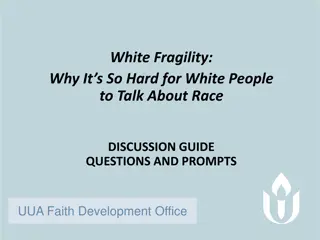Trends in Fragility: Challenges and Commitments in INCAF Network
The International Network on Conflict and Fragility (INCAF), a member of the OECD Development Assistance Committee, addresses the complex issues of delivering results in fragile contexts. By 2030, a significant population will reside in fragile settings, highlighting the urgency for action. INCAF explores emerging trends like the Humanitarian-Development-Peace Nexus to support stability. Financial commitments in fragile states are crucial, with ODA playing a critical role. The top donors include the United States, Turkey, United Kingdom, Germany, and Japan among others, with a focus on bilateral and multilateral aid distribution.
Download Presentation

Please find below an Image/Link to download the presentation.
The content on the website is provided AS IS for your information and personal use only. It may not be sold, licensed, or shared on other websites without obtaining consent from the author.If you encounter any issues during the download, it is possible that the publisher has removed the file from their server.
You are allowed to download the files provided on this website for personal or commercial use, subject to the condition that they are used lawfully. All files are the property of their respective owners.
The content on the website is provided AS IS for your information and personal use only. It may not be sold, licensed, or shared on other websites without obtaining consent from the author.
E N D
Presentation Transcript
INCAF Fragility Trends
The International Network on Conflict and Fragility (INCAF) An OECD Development Assistance Committee member network 30 member state donors + UAE, Saudi Arabia, Kuwait, Turkey + MDBs + IMF + UNDP and OCHA Tackling the tough challenges of delivering results in fragile contexts Policy commitments / Good practice and learning / Emerging Trends 2019/20: The HDP Nexus Prevention Fit for Fragility States of Fragility Financing for Stability INCAF
What is Fragility?
By 2030, 2.3 billion people will be living in fragile contexts The average median age is 20 years (vs 33 in rest of world) More than half of fragile contexts are Middle Income Countries Gender inequality is highest in fragile contexts By 2030, if no action is taken, fragile contexts will be home to more than 80% of the world s extremely poor States of Fragility 2018
In 2017, USD 74.3 billion, or 69% of ODA, went to fragile contexts 80 USD Billion 70 60 50 ODA to Fragile Contexts 40 ODA to non-Fragile Contexts 30 20 10 0 2000 2001 2002 2003 2004 2005 2006 2007 2008 2009 2010 2011 2012 2013 2014 2015 2016 2017 States of Fragility
In the 15 extremely fragile countries, ODA is critical ODA Remittances FDI 0 5 10 15 20 25 30 35 40 USD Billion States of Fragility
Half of all ODA to fragile contexts goes to just ten countries Syrian Arab Republic Ethiopia Afghanistan Bangladesh Nigeria Yemen Iraq Tanzania Kenya Democratic Republic of the Congo 0 2000 4000 6000 8000 10000 USD Million 12000 States of Fragility
The ten top donors: United States Turkey United Kingdom Germany Japan France United Arab Emirates Sweden Canada Norway 0 2000 4000 6000 8000 10000 12000 14000 16000 USD Million Of this, two-thirds is bilateral, one-third multilateral States of Fragility
Humanitarian ODA has more than doubled from 9.5 billion USD in 2010 to 20.1 billion USD in 2017 or 26% of ODA to fragiles 70 USD Billion 60 50 40 Humanitarian Peacebuilding 30 Development 20 10 0 2010 2011 2012 2013 2014 2015 2016 2017 States of Fragility
Some worrying trends: In 2016, only 2% of total ODA to fragile contexts went to conflict prevention. Only 10% went to peacebuilding Between 2015-17, at least USD 26 billion was spent on refugee situations Two-thirds of fragile contexts would have difficulty financing basic services from their own revenue but only 0.2% of ODA was used for domestic resource mobilisation Less than 10% of ODA to fragile contexts is for climate/environment With humanitarian increasing, there may not be enough attention for ending need. States of Fragility
Trends in terms of programming: New actors: World Bank, MDBs, IMF, Arab donors, China People at the centre: Local systems / self-reliance (rather than statebuilding) Shifting needs: OECD Lives in Crises surveys show that people in conflicts want jobs, and children in conflicts still need to go to school Prevention: But uncertain what this means in practice The Nexus: This wicked problem of fragility is too complex for one set of actors to tackle alone...
The Nexus Because most humanitarian programming is UN/NGOs (88%) But most development programming is bilateral (74%) The DAC Recommendation on the Humanitarian Peace Nexus Coordination Programming Financing
Challenges and Opportunities Narrative not LRRD with a new name! Coordination Strategic, Normative, Operational Defining peace and linking to peace actors Financing: The right amount: expensive in the short term The right tools: not about a pooled fund - there is no silver bullet do we need new instruments or a new approach to financing? earmarking financial literacy The right time: phasing and sequencing contingency finance and crisis modifiers The right incentives: A return to the livelihoods model? Sustainable solutions involve DRM and budget allocations Making humanitarians comfortable in this space























